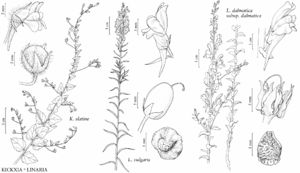Linaria
Gard. Dict. Abr. ed. 4, vol. 2. 1754.
| Taxon | Illustrator ⠉ | |
|---|---|---|
 | Kickxia elatine Linaria vulgaris Linaria dalmatica subsp. dalmatica | Barbara Alongi Barbara Alongi Barbara Alongi |
Herbs, perennial or annual; caudex woody or herbaceous, shoot buds arising from roots. Stems prostrate to erect, glabrous or glandular-pubescent in inflorescence. Leaves cauline, usually whorled proximally, alternate distally; petiole absent; blade sometimes ± fleshy, not leathery, margins entire. Inflorescences terminal, racemes, compact to elongate; bracts present. Pedicels present; bracteoles absent. Flowers bisexual; sepals 5, proximally connate, calyx ± bilaterally symmetric to nearly radially symmetric, 5-lobed, lobes linear to linear-lanceolate, lanceolate, ovatelanceolate, or ovate; corolla violet, blue, purple, red, yellow, or white, bilaterally symmetric, bilabiate, subcylindric, tube base not gibbous, spurred abaxially, lobes 5, abaxial 2, adaxial 3, abaxial lip as long as or slightly longer than adaxial, adaxial erect-patent to patent, with palate ± occluding mouth of tube; stamens 4, basally adnate to corolla, didynamous, filaments usually hairy proximally; staminode 1, scalelike; ovary 2-locular, placentation axile; styles simple or 2-fid; stigma capitate, clavate, linear, 2-lobed, or emarginate. Fruits capsules, 9–12 mm, dehiscence poricidal, each loculus wall later splitting into valves. Seeds 3–122, gray, brown, or black, globular, reniform, trigonous, tetrahedral, or disciform, wings present or absent. x = 6.
Distribution
Introduced; Europe (especially Mediterranean region), w Asia, n Africa, also in temperate regions of s South America (Argentina), Pacific Islands (New Zealand), Australia
Discussion
Species 150 (10 in the flora).
In this treatment, the species are arranged following the infrageneric classification proposed by D. A. Sutton (1988), with 150 species in seven sections; our ten belong to four of these sections.
North American species of Linaria canadensis (Linnaeus) Dumont de Courset, L. floridana Chapman, and L. texana Scheele included in sect. Leptoplectron Pennell, an invalidly published sectional name, have been included in Nuttallanthus, which differs from Linaria in having the abaxial lip of the corolla greatly exceeding the adaxial lip, a weakly developed palate, and prismatic seeds usually with prominent longitudinal ridges. Phylogenetic studies of Linaria and Nuttallanthus based on nuclear ribosomal DNA ITS sequences (M. Fernández-Mazuecos et al. 2013) concluded that on the basis of morphological traits and phylogenetic results, it would probably be appropriate to circumscribe Nuttallanthus species as a section (sect. Lectoplectron) of Linaria.
Linaria species often are cultivated and some (such as L. bipartita, L. dalmatica, L. triornithophora, and L. vulgaris) become naturalized; how long they may persist is unknown.
Although Linaria supina (Linnaeus) Chazelles de Prizy subsp. supina (lesser butter-and-eggs) has been collected in several states (New Jersey, New York, and Pennsylvania), all of the collections were made before 1900, and L. supina has yet to become established in the flora area. It would key closest to L. vulgaris, having shorter fertile stems [5–24 cm versus (25–)35–90(–120) cm], smaller corollas (15–25 mm versus 27–33 mm), and globular (versus oblong-globular or ovoid) capsules. The report from Massachusetts by C. H. Knowlton and W. Deane (1923) was based on a cultivated plant (10 July 1863, Boott s.n., GH), and the report from California is an error (http://ucjeps.berkeley.edu/cgi-bin/get_IJM.pl?tid=11372).
Selected References
None.
Lower Taxa
Key
| 1 | Styles 2-fid; stigmas with 2 discrete areas; seed wings absent; annuals [sect. Versicolores]. | > 2 |
| 2 | Racemes: rachis glandular-hairy, hairs 0.1–0.7 mm; capsule loculi subequal to unequal. | Linaria maroccana |
| 2 | Racemes: rachis glabrous or sparsely glandular-hairy, hairs 0.1–0.4 mm; capsule loculi equal, sometimes subequal. | > 3 |
| 3 | Corollas purple, mauve, or violet, usually with yellow palate. | Linaria bipartita |
| 3 | Corollas yellow. | Linaria spartea |
| 1 | Styles simple; stigmas entire; seed wings present or absent; perennials (some plants may bloom first year). | > 4 |
| 4 | Seeds disciform, subglobular, elliptic-globular, or deltate-globular, with prominent encircling wing. | > 5 |
| 5 | Corollas 27–32(–33) mm, white, pale yellow, or bright yellow, sometimes with orange palate [sect. Vulgaris]. | Linaria vulgaris |
| 5 | Corollas 35–57 mm, violet, blue-violet, reddish purple, or pink, rarely white, with yellow, white, or lilac palate [sect. Pelisserianae]. | Linaria triornithophora |
| 4 | Seeds trigonous, subtrigonous, or ± tetrahedral, wings absent [sect. Speciosae]. | > 6 |
| 6 | Spurs 2–5 mm; corollas white or pale lilac. | Linaria repens |
| 6 | Spurs 5–30 mm; corollas yellow or violet to purple. | > 7 |
| 7 | Corollas violet to purple, with yellow or lilac palate. | Linaria purpurea |
| 7 | Corollas pale to bright yellow. | > 8 |
| 8 | Corollas 16–20(–23) mm; spurs 7–9(–10) mm. | Linaria genistifolia |
| 8 | Corollas 27–52 mm; spurs 11–30 mm. | > 9 |
| 9 | Corollas: adaxial lip sinuses 2–3.5(–4) mm; calyx lobes (1.9–)3–9.5 × (0.9–)1–3.5 mm in flower. | Linaria dalmatica |
| 9 | Corollas: adaxial lip sinuses 4–6 mm; calyx lobes 7–14 × 3.5–7 mm in flower. | Linaria grandiflora |